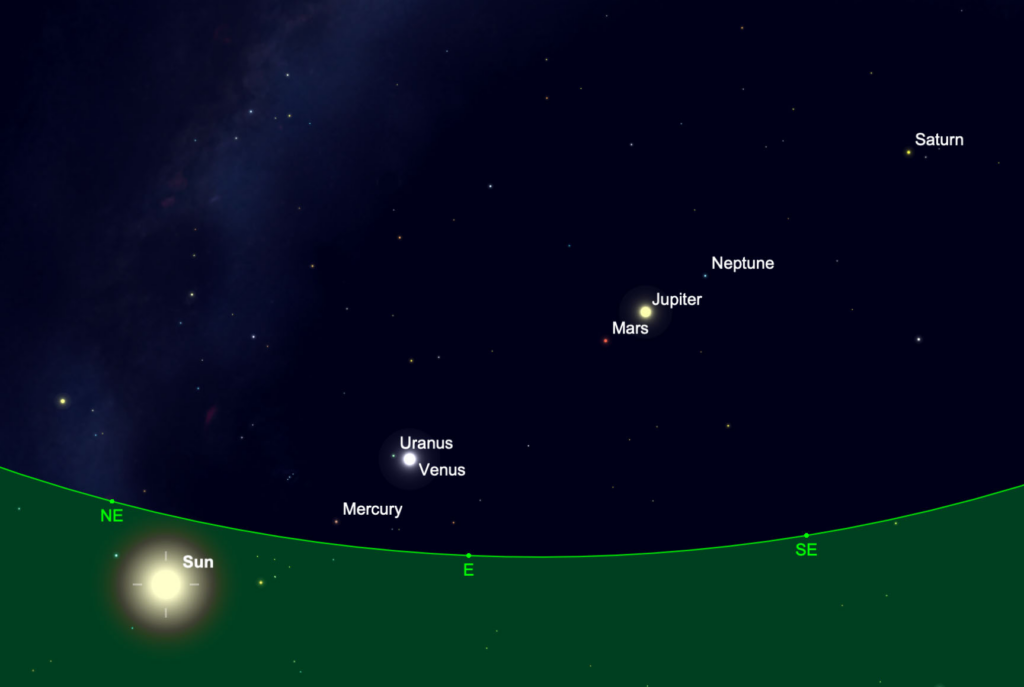Sky Report: June 6 – 12

June 10, 45 minutes before sunrise with all 8 planets and the brightest stars. The horizon is translucent so you can see through it to the sun. Graphic created with SkySafariAstronomy.com.
All the planets are in the morning sky, leaving the evening sky full of stars and the moon. The two very bright stars that are in the south at around 10 p.m. are Spica, and above it, Arcturus. Spica is in Virgo and Arcturus is in Bootes. Notice their contrasting colors: Spica is pure white while Arcturus has a distinct yellowish cast. A star’s color tells you its surface temperature; orange is cool and white is hot; red is even cooler and blue even hotter. Spica has a temperature of 47,000°F while Arcturus is 7700°F, and you can see the difference with your eyes alone.
Look closer to the southeastern horizon to see Antares which has just risen. Antares is the red heart of the Scorpion (do scorpions have red hearts? – rhetorical question). Antares is red, although you’ll see it as orange, and its temperature is 5800°F. That’s hot for you and me but exceptionally cool for the surface of a star. For comparison the sun’s surface temperature is about 10,000°F – and it looks white.
Actually Spica is blue-white but your eyes will see it as white.
Telescopes increase your ability to see the colors of stars by funneling more photons into your eyes which triggers more color receptors. Telescopes magnify color as well as brightness.
The moon is near Spica on the 9th and Antares on the 12th.
The morning sky is full of planets – all but Mercury, which is too close to the sun to be seen. They are Venus, brilliant but low in the east 45 minutes before sunrise; Jupiter, not as bright but much higher; Mars, fainter yet and to the lower left of Jupiter; Saturn, as bright as Mars but far to the right, in a line with the others, in the southeast.
Mars orbits the sun faster than Jupiter. Mars passed close to Jupiter on May 29 (I presume you were watching) and is now visibly separating from it at the rate of ½° per day.
There’s more. Uranus is 1½° from Venus on the 11th and 12th, although you won’t see it because it’s too faint in morning twilight, and Neptune is roughly as far to the upper right of Jupiter as Mars is to the lower left. Of course all planets are in a line because the solar system is flat and we see it edge-on. You should see Neptune with a telescope if you look early, before the sky brightens with the approaching sunrise.
A heads-up for people with good binoculars or better-yet a small telescope and star-charting software: look for Comet C/2017 K2. The comet is inbound, and when at its closest in December might reach 6th magnitude and be easily visible in binoculars, but with modest equipment you can see it now, at 8th magnitude, around midnight in northern Ophiuchus. It passes near the 8th-magnitude planetary nebula NGC 6572 for several days around the 7th. I’ll have more on this interesting comet later in the year when it’s brighter.
Through a 2021 grant from the Utah Governor’s Office of Economic Opportunity and the Kane County Office of Tourism, Stellar Vista Observatory provides portable telescopes and tripod mounted binocular kits on loan for free to residents and visitors in Kane County. Enhance your enjoyment of the night sky! For details or to request a loan, visit https://stellarvistaobservatory.org/discover-the-night-sky/ or drop in to the Kane County Office of Tourism.
The Sky Report is presented as a public service by the Stellar Vista Observatory, a nonprofit organization based in Kanab, Utah, which provides opportunities for people to observe, appreciate, and comprehend our starry night sky. Additional information is at www.stellarvistaobservatory.org. Send questions and comments to John@StargazingAdventures.org.






Comments are closed.